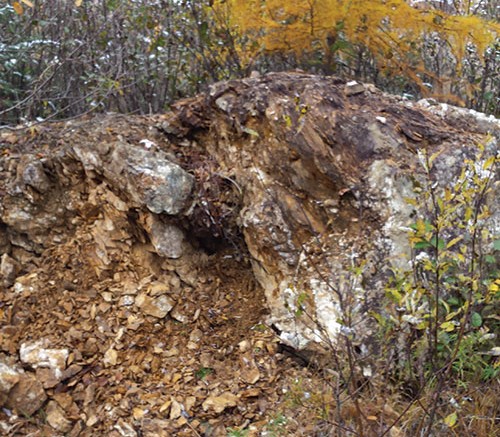Chairman and CEO Bradley Kitchen and his team at Secova Metals (TSXV: SEK; US-OTC: SEKZF) hope that returning to a familiar jurisdiction can lead to a new exploration success story. The company is gearing up to start geophysical work at the historic 45 sq. km Duvay property, 90 km southeast of Val-d’Or, and Kitchen says his team’s experience with Quebec gold deposits can help unlock the site’s potential.
Kitchen was president of Eagle Hill Exploration in mid-2013, and advanced the Windfall Lake gold deposit alongside geologist Jean-Philippe Desrochers. The project was scooped up and rolled into Oban Mining (TSX: OBM; US-OTC: UBNNF), which is consolidating junior Canadian gold assets. At the time of the deal, Windfall had seen $27 million in investment and emerged as a multimillion ounce gold project.
“I took a bit of time after the Eagle Hill deal before looking for our next venture. We stumbled upon Duvay, which represented an appealing opportunity from an infrastructure and jurisdictional point of view,” Kitchen said during an interview. “We have power, telephone and Internet right on the property, and we have a large core shack. There has been exploration at the site going back to the 1940s, and we see real similarities to Windfall Lake.”
Duvay sits along the eastern reaches of Quebec’s Abitibi greenstone belt, which is known for its orogenic lode gold deposits. The project hosts the Duvay, Malllich and Semac gold showings, which are associated with a major shear zone.
The property hosts a historic resource of 6.7 million tonnes of 2.06 grams gold per tonne “amenable to open-pit mining.” Duvay was explored by Tres-Or Resources (TSXV: TRS; US-OTC: TRSFF), which optioned the property to Aurizon Mines in 2011.
The companies conducted a drill campaign, but Duvay reverted to Tres-Or ownership in early 2013, when Hecla Mining (NYSE: HL) took out Aurizon for just under $800 million.
“The historic resource is interesting, because you have a lower-grade, open-pit scenario, and higher-grade underground potential. The resource work at Duvay encompasses a limited area to fairly shallow depths, so we believe there is plenty of expansion potential on the property,” Kitchen said.
“This is an extension of work that’s been done in the past to build up the geologic knowledge base. We’re going to explore over a strike length that runs in excess of 1 km. There’s been a lot of drilling on the property, but there hasn’t been a strategic and comprehensive exploration program,” he added.
Secova negotiated an option agreement with Tres-Or wherein it can earn a 65% interest in Duvay for $500,000 in cash and $3.8 million in exploration over four years. The company can pick up another 25% in the project through $12 million in expenses and a prefeasibility study.
Tres-Or and Aurizon spent in excess of $4 million at Duvay, where the historic database includes over 300 drill holes and bulk-sample results. Aurizon’s work at the project was never published, but historic assay highlights from program in the late 1980s include: a 11.3 grams gold over 20 metres from 18 metres deep in hole 25; and 10.5 grams gold over 35.3 metres from 34 metres in hole 139.
“What we did in the case of Eagle Hill was take a project where nobody could put together a geological model — despite strong exploration results, and a lot of investment — and advance it to the point where it became a promising deposit that was eventually purchased,” Kitchen said. “That was essentially our story. You take that potential and develop it to the point where someone wanting an asset for production could take it over. What we envision with Secova is ‘Eagle Hill part two.’”
Secova is closing a $950,000 non-brokered private placement, wherein it will issue 10 million flow-through shares at 7.5¢ each, and 4 million hard shares at 5¢ each. The company closed the first tranche in December, when it issued 5 million flow-through shares and 1 million hard shares for $425,000 in gross proceeds.
It plans to finish an induced-polarization survey and pursue Duvay’s gold mineralization to depth. Previous work had focused on an area that runs 250 by 250 metres, and remains relatively near-surface. The company hopes to drill 10 holes 200 metres deep or more later this year.
“What we need to leverage is a systematic and methodical understanding of project geology that will allow us to determine the true upside of the asset,” Kitchen said. “That’s always what we’ve done in the past. Most of my history is in structured finance, and I try to bring that dealmaking mentality to the junior space, and we’ve proven we can be successful. It’s all about investing in strong geologists and advancing an asset with a true eye on production.”
Secova has traded within a 52-week range of 3¢ to 9¢, and closed at 5¢ per share at press time. The company has 36 million shares outstanding for a $1.8-million market capitalization, with Vancouver-based Delbrook Capital holding a 19.9% equity stake.


Be the first to comment on "Secova’s Kitchen looks to repeat success in Quebec"